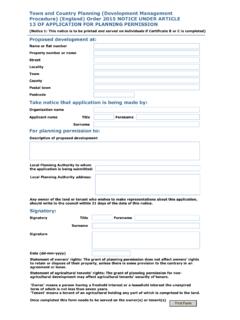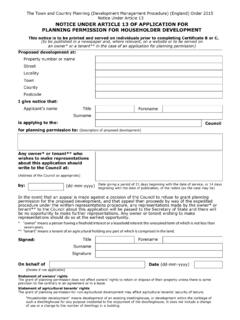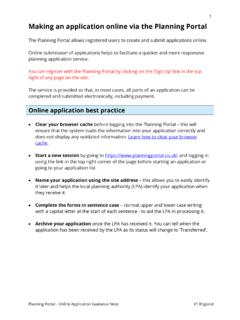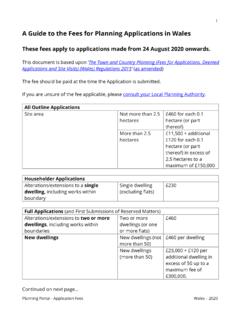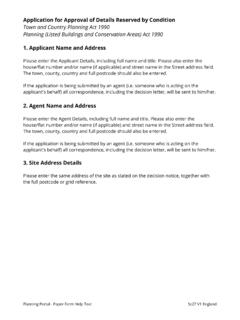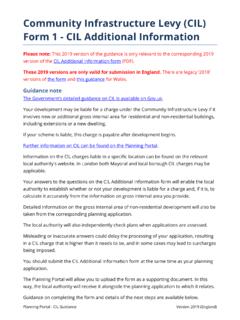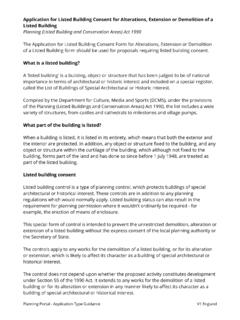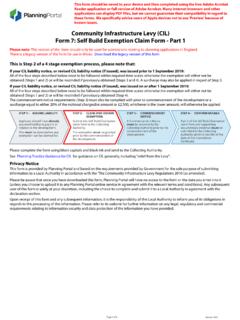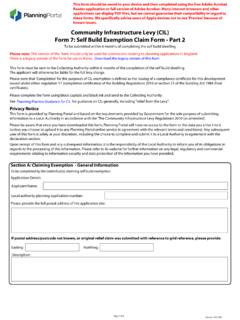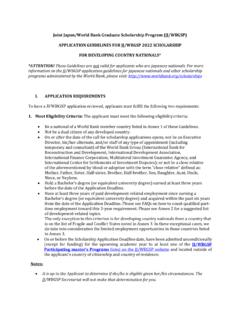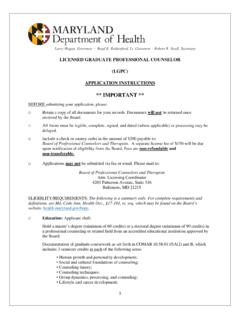Transcription of Application to determine if prior approval is required for ...
1 Planning Portal - Application Guidance V2019 Application to determine if prior approval is required for a proposed: Larger Home extension The Town and Country Planning (General Permitted Development) (England) Order 2015 (as amended) - Schedule 2, Part 1, Class A Under the conditions set by permitted development legislation, householders are able to build larger single-storey rear extensions in certain circumstances. Generally, single-storey rear extensions must not extend beyond the rear wall of the original house* by more than four metres if a detached house; or more than three metres for any other house. However, where not on Article 2(3) land* or in a Site of Special Scientific Interest, this limit is increased to: eight metres if a detached house; or six metres for any other house. Before development commences, the relevant local planning authority must be notified of the proposed work so that they can determine if their prior approval is required for the extension , based on consultation with neighbouring properties.
2 This is done by completing and submitting a prior approval : Larger Home extension Application , including the necessary supporting information and the correct fee. This can be done online through the Planning Portal or by downloading a printable form. A process then takes place as detailed on the following pages. Please note: It is not possible to undertake this process retrospectively. * The term "original house" means the house as it was first built or as it stood on 1 July 1948 (if it was built before that date). Although you may not have built an extension to the house, a previous owner may have done so. * Article 2 (3) land is land within: a conservation area; or an area of outstanding natural beauty; or an area specified by the Secretary of State for the purposes of enhancement and protection of the natural beauty and amenity of the countryside; or the Broads; or a National Park; or a World Heritage Site Planning Portal - Application Guidance V2019 Notification and prior approval process Government has introduced a 96 fee for this process that applies to all applications from 19 August 2019 onwards.
3 You can claim an exemption to this fee if: The proposal is for extensions and alterations to a disabled person's dwelling house to improve access, safety, comfort, etc; or An Application for planning permission (for which a fee is payable) is being made by the same applicant on the same date for the same site, buildings or land as the prior approval Application . 1. A homeowner wishing to build a larger single-storey rear extension must apply to the local planning authority, providing: a. a written description of the proposal which includes the length that the extension extends beyond the rear wall of the original house, the height at the eaves and the height at the highest point of the extension b. a plan of the site, showing the proposed development and any existing enlargement of the original house that the proposals will join to.
4 C. the addresses of any adjoining properties (this should include any premises to the side/front/rear, even if they are not physically 'attached'). d. a contact address for the applicant (the householder) and an email address if they want receive correspondence by email A plan drawn to an identified scale will assist the authority in assessing your development proposal. Plans can be bought from one of our accredited suppliers using our Buy a planning map service. The information provided should include all the details necessary for the Local Authority to determine if the proposal complies with permitted development legislation, and if its prior approval will be required . If sufficient information is not provided the Local Authority can either request it, or refuse the Application . 2. The local authority will serve a notice on adjoining owners or occupiers, those who share a boundary, including to the rear.
5 This will give the address of the proposed development and describe it, including the information in 1(a) above. A copy of this notice will also be sent to the developer..continued on next Planning Portal - Application Guidance V2019 It will also set out: a. when the Application was received, and when the 42-day determination period ends b. how long neighbours have to make objections (which must be a minimum of 21 days), and the date by which these must be received 3. If any adjoining neighbour raises an objection within the 21-day period, the prior approval of the local authority will be required to determine if the proposal s impact on the amenity of all adjoining properties is acceptable. 4. The development can go ahead if the local authority notifies the developer in writing either: a. that, as no objections were received from adjoining neighbours, it s prior approval is not required , or b.
6 That, following consideration, it has determined that the effect on the amenity of adjoining properties is acceptable Please note: All the other restrictions and eligibility criteria on permitted development for extensions continue to apply. See further details on the Planning Portal. 5. If the local authority does not notify the developer of its decision within the 42-day determination period, the development may go ahead. 6. If approval is refused, the developer may appeal. 7. The extension must be built in accordance with the details approved by the local authority (or, if no objections were raised or the local authority has not notified the developer of its decision, the details submitted), unless the local authority agrees any changes in writing. 8. The development must accord with all other relevant limitations and conditions which apply to other rear extensions allowed under permitted development.
7 These are set out in Class A, and include for example, the requirement that the extension must be constructed using materials of a similar appearance to those used in the construction of the rest of the house. See further details on the Planning Portal.
